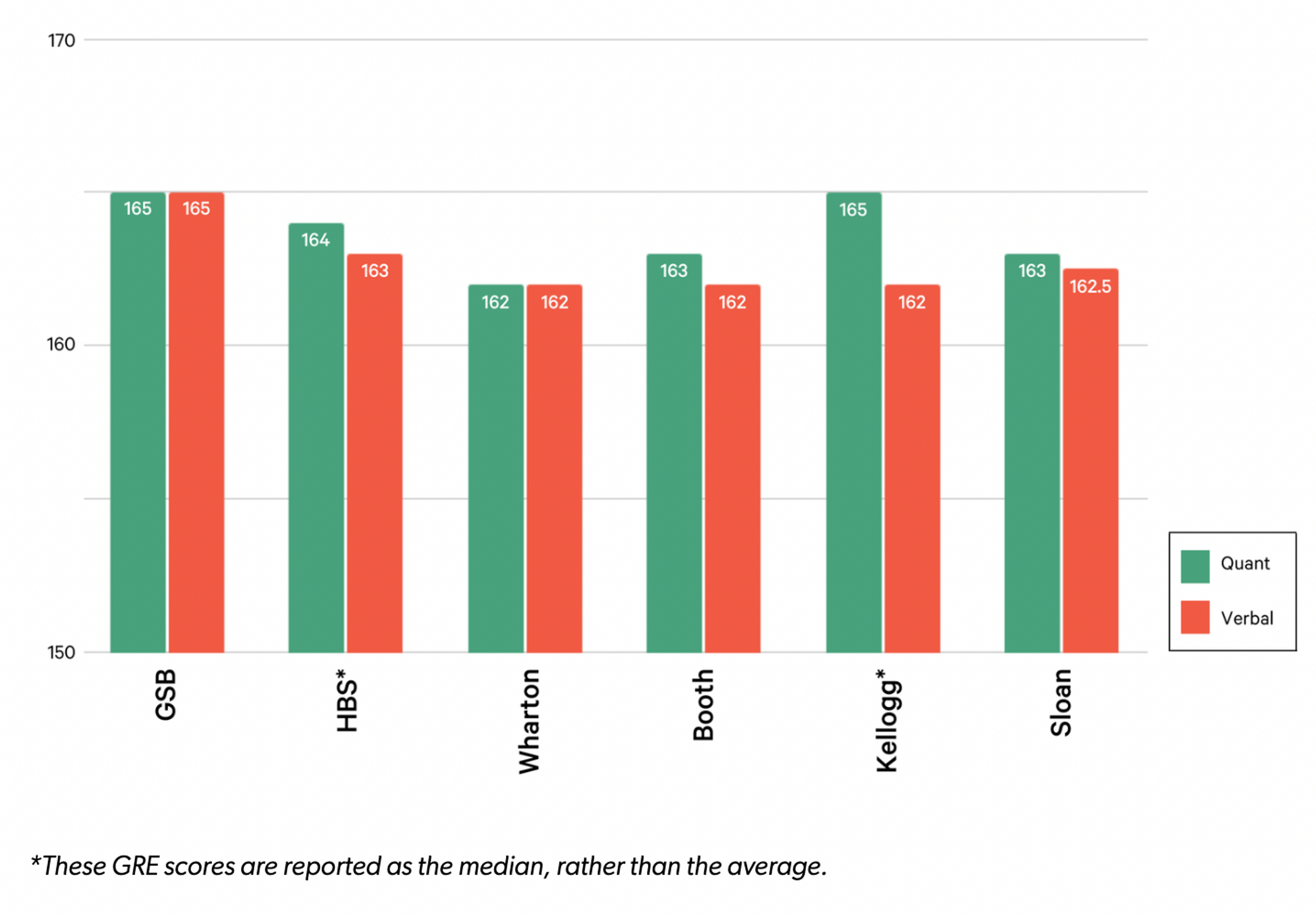Nail the GMAT/GRE in 60 Days
A Nuts and Bolts Guide to the GRE and GMAT: Comparisons, Scoring Methods, Registration Info, and More
A comprehensive guide to the GRE and GMAT, including a side-by-side comparison of the two tests' structures, an in-depth overview of the scoring methods, registration information, and more.
Posted June 13, 2025

Join a free event
Learn from top coaches and industry experts in live, interactive sessions you can join for free.
Table of Contents
The GRE and GMAT are the two tests that business school applicants are able to take for their standardized test score submission. Top MBA programs want to see that the student can perform well on exams and that they have the requisite base level knowledge to succeed in the program itself. The GRE and GMAT are different substantively, as well as in how they’re scored, their length, and more, and it can be difficult to know which one is better for you.
This guide will walk you through the nuts and bolts of these exams including their length, the number of questions, when to take them, how much they cost, how they’re scored, how many times and how often you can take them, and when the results come, to help you make a more calculated decision as you begin to study.
For personalized, one-on-one GRE/GMAT coaching, work with a Leland expert. Browse our GMAT Coaches and GRE Coaches.
An Overview of the Test Structures: Length, Questions, Sections, and More

What Does This Mean?
This comparison shows a few insights. One of the biggest differences between the two exams is the amount of time spent on writing. While those who take the GMAT will write for 30 minutes, the GRE’s equivalent section takes 60 minutes. Also, the GMAT includes an integrated reasoning section that involves using data to solve complex business problems. Taking that into account, the GMAT includes about 20 more minutes of quantitative problem-solving than the GRE.
This would indicate that those who are strong in writing should take the GRE, and those who feel better about their quantitative skills should take the GMAT.
The Scores: GRE
Both the Verbal and Quantitative Reasoning sections are reported on a scale of 130-170 in one-point increments. The Analytical Writing sections are reported on a scale of zero to six, in half-point increments.
Verbal and Quantitative Reasoning:
The two reasoning sections of the GRE (verbal and quantitative) are adaptive, meaning that the computer will automatically adjust the second part of each section depending on the test taker’s performance on the first part. The questions from both parts contribute equally to the final score.
The raw score is the number of correct answers from each section. That raw score is converted into a scaled score through a process that accounts for variations in the questions and parts’ different levels of difficulty.
Analytical Writing:
The analytical writing sections are scored by a trained rater who grades them based on a holistic six-point scale, as well as a computerized program that is able to identify features of writing proficiency. If the two scores are similar, the final scores will be an average of the two. If the computer and human scores are very different, a second person will grade them and the final score will be the average of the two human scores.
There is only one score provided for both writing sections and is it comprised of the average of each essay’s final scores. The averaged score is rounded to the nearest half-point interval on the 0-6 score scale.
Rather than emphasizing grammar and mechanics, the GRE looks for critical thinking and analytical writing. For a score of 5.5-6, the writer will need to accomplish the following things:
- Sustain an in-depth analysis of complex ideas
- Support their ideas with logical reasoning
- Be persuasive, focused, and organized
- Include a variety of sentence structures, vocabulary, and language uses that convey meaning precisely and effectively
- Writing may have minor errors but they do not affect the meaning
As a comparison, a score of 1.5-2 will have the following:
- A substantial lack of analysis/development
- Not focused or organized
- Frequent errors in sentence structures and language that affect the meaning
Length of Validity, Sending Scores to Schools, and Result Timelines
GRE scores are valid for five years from the test date. For example, scores from a test taken on March 16, 2022 will be valid until March 15, 2027.
As for reporting scores to schools, test takers have two different options. After finishing the exam, they’ll be able to see their results and choose whether they’d like to send their scores at that time to four schools of their choice as a part of their test fee.
If they do not know which schools they are targeting yet, want to send them to more than four schools, or are not satisfied with their scores, they’ll have to opportunity to send the results at a later date for an additional fee. The scores take about five days to be processed and sent.
As mentioned above, the quantitative and verbal reasoning sections’ scores will be available to view immediately after the exam. The full report, including the analytical writing scores, will be available to view 10-15 days after the test date.
M7 GRE Average Scores
Here are the average GRE scores for the M7 business programs, except for Columbia Business School which doesn’t report them.

The Scores: GMAT
The total GMAT score is not curved as it is supposed to remain consistent over time. This means that a GMAT score from ten years ago will indicate the same level of performance of that score today. It is also not calculated from the Quant and Verbal sections’ individual numerical scores. Instead, the computer calculates the total score based on the test taker’s overall performance on all the non-experimental questions. The Quant and Verbal sections represent different ranges of performance so two students who get the same scores on both of those sections may end up with completely different total scores.
Verbal and Quantitative Reasoning:
Like the GRE, the verbal and quantitative reasoning sections are computer adaptive at the question level. This means that the computer algorithm will automatically adjust the difficulty level of one question depending on the level of the previous one. For this reason, a long streak of correctly answered questions can have an important effect on scores. As longer streaks will increase the difficulty of questions, long correct-answer streaks can significantly drive up the score. The computer adaptivity does not reach across sections. So, the quant section’s level of difficulty will have no bearing on the verbal section.
The reasoning sections are graded around three parameters: the number of questions answered, how many questions were answered correctly, and the difficulty levels of the questions. Those that answer a high quantity of questions correctly, and qualify for questions that are harder, will get a higher overall score. There are five fewer questions in the Quant section than in the Verbal section so each Quant question matters more for the section score. For this reason, if the test-taker is running out of time, it is much better to make an educated guess than leave questions blank.
The number of points available for these two sections is 6-51 (in intervals of one). They are on a fixed scale and as such, can be compared across different test administrations. These sections are the only ones factored into the total score.
It’s also important to note that the percentile rankings are not based on the number of questions correct, but rather on a comparison with other test-takers over a period of the three most recent years. Here are the percentiles for top GMAT scores from 2018-2020.
99%: 760-800
98%: 750
97%: 740
96%: 730
94%: 720
91%: 710
88%: 700
85%: 690
81%: 680
80%: 670
76%: 660
72%: 650
Integrated Reasoning:
The score of this section comes from the number of questions answered correctly. Most of the questions require multiple parts–as it’s testing how data can be integrated into complex problems–and each part must be answered correctly in order to receive credit for the question.
The section will receive a score of one to eight and it is graded in intervals of one. While it is not factored into the total score, it does affect percentile ranking.
Analytical Writing Assessment:
The writing section is scored the same as the GRE, through a combination of computer algorithms and human raters. If the two disagree and the gap is greater than one point, a third human will review the score and it may be changed. The scores can range from zero to six in half-point increments.
An AWA with a score of six will be a “cogent, well-articulated critique of the argument, demonstrating mastery of the elements of effective writing” (GMAC Guidelines) and will have the following things:
- Clearly identifies and analyzes the principle features of the argument
- Ideas are developed convincingly and are organized, logical, and connected with smooth transitions
- The arguments are supported by effective points
- Strong control of language, including a variety of syntax and diction and proper grammar
- There may be minor flaws
This section, like IR, is not factored into the total score. The online version of the GMAT does not include analytical writing so those that take it online will not receive an AWA score.
Length of Validity, Sending Scores to Schools, and Result Timelines
Like GRE scores, GMAT scores are valid for up to five years and can be reported for up to ten. However, if there are any scores available within five years, those will be the only ones reported. Immediately after taking the exam and viewing the unofficial report, test-takers have the option to cancel their scores for free or within 72 hours online for a fee of $25. They will not be shown on score reports. The canceled scores can be reinstated up to four years and eleven months after the date of the exam for $50 (plus $10 if reinstated by phone).
Test takers can choose to send their scores to five schools for no additional fee on the day of the exam. They must be designated before the start of the test. The scores can be sent to an unlimited number of schools after the test day for an additional, non-refundable fee of $35. Once the request has been submitted, it cannot be undone.
Unofficial scores can be viewed immediately after the exam is done. The test-taker will have two minutes to decide whether they’d like to accept or cancel them. The official score report will be available within 20 days of the exam date. Pearson VUE will send a notification email after which the test taker can view, download, and print their official scores.
M7 GMAT Average Scores

When to Take the GRE/GMAT for Business School
Though not always possible, it’s a good idea to take the GRE/GMAT several months before the application deadline to give yourself a solid cushion. That way, if you aren’t satisfied with your scores, you have more time to study and retake them.
This also means that you should start studying well before the 2-3 months prior to the deadlines. For example, if you’re planning on applying in December, try to take the test by September. On average, it takes students 1-3 months to study, depending on the amount of time they are able to dedicate in that timeframe. The equivalent of this in hours is 50-200 on average. However, everyone’s study needs will vary drastically. The more time that you can give yourself to study and get the score you want, the better.
How to Register for the GRE and GMAT
GRE
The GRE is administered in over 1000 locations across 160 countries. Seats are given on a first-come, first-served basis so it’s better to register as early as possible to get your preferred location and time. Test takers can choose to register via phone or online. Test takers who wish to take the exam from home in Mainland China, Hong Kong, Taiwan, or Korea, must register online.
Below are the steps for registering online:
- Create an ETS account here
- Select Register/Find Test Centers on the home page
- Verify your email address and time zone
- Choose a two-month period in which you wish to take the test and select a specific date
- Choose an available time and click “Register for this test.”
- Pay for your test
If you’d prefer to register via phone, follow these steps:
1. Test takers based in the US, Canada, US Virgin Islands, or Puerto Rico should call this number: 1-443-751-4820 or 1-800-473-2255
2. Register and pay for your test.
Those based in the US can reschedule or cancel their test on ETS.
GMAT
Test takers can register for the GMAT starting six months before their preferred test date and up to 24 hours; however, as spots fill up it’s good to register at least two or three months in advance. There are four different ways to register for the GMAT: online, phone, fax, or postal mail.
Here is how to register online:
1. Create an account on mba.com here
2. Click “Register now” under Exams → GMAT
3. Enter your personal information and the optional information if you choose to do so
4. Verify your email address
5. Select the three most preferred test centers and review availability
6. Select a time and date
7. Pay the registration fee
If you choose to register by phone, a customer service representative will fill in the information for you. Here are the numbers for several different regions:
The Americas: +1 (800) 717-4628 (Toll-free) or +1 (952) 681-3680
7am-7pm CST
Asia-Pacific: +852-3077-4926 (India: +91 120-439-7830)
9am-6pm AEST (or 9am-6pm Indian Standard Time)
China: +86-10-82345599
8:30am-5pm China Standard Time
Europe, Middle East, and Africa: +44 (0) 161 855 7219
9am-5pm GMT
How Many Times and How Often You Can Take the GRE and GMAT?
You can take the GRE once every 21 days up to five times within a 12-month continuous period. Canceled scores do still count as a test taken. There is no lifetime limit on the number of times you can take the test.
You can take the GMAT up to five times within a 12-month period as well, with at least 16 days in between attempts. There is a lifetime limit of eight on the total number of times someone can take the GMAT.
What to Bring on Test Day
The only things you need to bring for the GRE are a valid form of identification and a mask. You may or may not be required to wear it but must bring it nonetheless. You may also bring a light jacket/sweater and any prescription glasses. Don’t bring any kind of technology (watches, phones, tablets, etc.) or jewelry (other than wedding bands).
Arrive at least thirty minutes before your scheduled start time so that you’ll have plenty of time to go through the check-in process and get settled.
Where Can I Start?
Taking the GRE and GMAT can be a difficult process but thankfully, you don’t need to go through it alone. Here are some of our additional GRE and GMAT resources to help you navigate the journey.
The GMAT vs. GRE for Business School—Which to Take and How to Ace Both
Top 50+ Free Resources for GMAT/GRE Prep
Coach Recommendations
For more personalized guidance on studying for the GMAT/GRE, work with an expert Leland coach. Here are a few of our highest-rated coaches for the GRE:
And for the GMAT:
Final Note
Leland provides you with the content, community, and coaching that you need to get into your dream MBA program and accomplish other ambitious goals. Sign up today to gain access to additional free resources, community events, small group classes, world-class coaching, and more.
Browse hundreds of expert coaches
Leland coaches have helped thousands of people achieve their goals. A dedicated mentor can make all the difference.


























